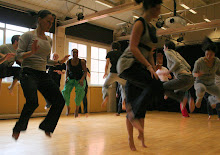The first phase, research developed the initial idea of Porto. At the very beginning, we were asked to bring in an item which represented ourselves in some way. These items were then used to develop the basis of what is now Porto. As we had already built our pallet, we then started experimenting with ideas and characters. We were left to our own devices when it came to our characters and it was up to us to devise and develop back stories and personalities for them, through research as well as physical work. Oddey states that: “Devised theatre encourages and supports the notion of a group of people having the chance to be artists in their own right, to discover their own creativity in form and content.” (1996.) pg. 164.
This is the reason that I think our transition from the research to the score phase has gone so smoothly. We have all kept the ideas of journeys with us throughout, which came from a series of pictures and images which had themes which were inspired by the items we initially brought in. Due to the fact the devising process started with a personal connection to each of us, we have been able to focus more on the physical experimentation.
Gradually music started being added to each section, which at first many people didn’t notice as we are often so engrossed within the work. Although we are a large group, there is often a strong connection and themes running through our physical work, which is now being defined but the use of music and extra play sessions. We are now at the score phase where music is an important factor to the community of Porto, but I also feel that the research phase is still apparent, and that it will be right until the end.
There are some sections which have a stronger narrative/structure than others. The ensemble sections are particularly strong to me. As we work in unison, it is clear we are ‘one’. The two ‘odd’ figures – Nicola and Blake, have an impact on us as a community as they don’t fit in with the rest of us. Due to this, sub groups start to emerge and many of us split. Then I feel that some narratives may be seen differently to different people-mainly due to the nature of the work and the fact that each character is individual, but yet still an important member of the community.
“In devised experimental theatre where the body is the primary signification of the text, the gestural language (through the combination of narrative, text and physical movement) is the performance vocabulary for the work”) Oddey, (1996) pg.162.
The fact that the body is the most important tool within this genre means that it is the body that creates the narrative and movements, not the other way around. As Callery points out: “Physical theatre is theatre where the primary means of creation occurs through the body rather than the mind.” (2001) pg. 4
My characters transition has been immense, but mainly over the past two weeks. Although the morals, feelings and emotions have remained the same, they now include other people – rather than just for her. My character is still as determined as ever, but now that such strong connections have been made with other members of the community, the focus is also on them and I am more intrigued at how others can help me find out more about myself as well as experimenting with how both my character, and other characters respond and react to each other. During my research phase, I envisioned for my character to go on the journey alone. But now, within the scoring process I don’t think she could achieve anything without the other characters she’s connected with.
D, Callery. Through the body: a practical guide to physical theatre. Nick Hern Books, 2001.
A, Oddey. Devising Theatre: A Practical and Theoretical Handbook. Routledge, 1996.
skip to main |
skip to sidebar
Welcome to Porto2009.
This is the begining of our journey on the road of Porto2009. And the blog will give us the opportunity as a group to reflect on the work in which we have done within the sessions. We will keep you posted regarding the process we are making along the way.....
Enjoy.
Enjoy.



No comments:
Post a Comment